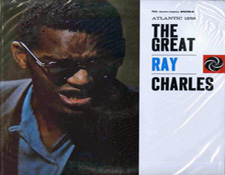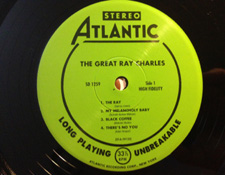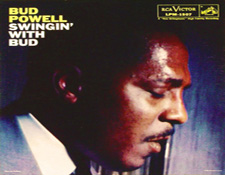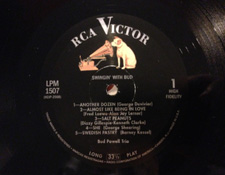It’s the time of year for saving money!
I get a little tweaky when it comes to piano music on vinyl. Why? Because of all instruments — with only orchestral strings running a close second — a poorly pressed LP can completely ruin the listening experience for me. I am not talking about clicks ‘n pops ‘n squeaks either here. I am talking about what I consider the biggest offense in record manufacturing: the off-center LP.
 This is usually due to shear sloppiness on the part of the pressing plant (at least as far as I can tell), resulting usually in one side that is fine while the other side wavers annoyingly, frequently to the detriment of the music within. An off center album of piano music can seriously kill the intended listening experience, where a emotive held note suddenly becomes a drunken siren. This problem has become so bad for me that I have consciously started to fine tune my collection when feasible, skewing toward high quality digital formats (SACD, DVDA, Blu-ray, HDTracks downloads, even CD) for any sort of music is easily impacted by off center-ness. This occurs in rock less frequently, but is more common among jazz and classical recordings.
This is usually due to shear sloppiness on the part of the pressing plant (at least as far as I can tell), resulting usually in one side that is fine while the other side wavers annoyingly, frequently to the detriment of the music within. An off center album of piano music can seriously kill the intended listening experience, where a emotive held note suddenly becomes a drunken siren. This problem has become so bad for me that I have consciously started to fine tune my collection when feasible, skewing toward high quality digital formats (SACD, DVDA, Blu-ray, HDTracks downloads, even CD) for any sort of music is easily impacted by off center-ness. This occurs in rock less frequently, but is more common among jazz and classical recordings.
However, when I find some nice piano albums that sound real nice on vinyl, its a treat. Here are two I’ve picked up recently you might want to consider.
 The Great Ray Charles was an unexpected find over at Streetlight Records here in San Francisco, a nice reissue of a vintage 1957 album of vocal-less piano jazz performances with arrangements by Quincy Jones. Pressed at RTI on nice 180-gram vinyl, the laquers were cut by Doug Sax at the mastering lab and it sounds fabulous. I was worried when I took the disc out of the sleeve as the vinyl is not perfectly black — it has some of that splotchy grey/cloudy look you see sometimes — but when I put it on the turntable it plays dead quiet. Most importantly for this type of music, which features Ray on piano as a band member in laid back small group settings (drums, bass and some horns), the album is well centered so there are no wavering notes getting in the way of enjoying the performance. This album is a keeper, with a great natural piano sound, well recorded drums where you can hear fine details such as the movement of the brushes on the snare head. If there is any wavering of the piano sound, as I heard a little on Ray’s original piece “Sweet Sixteen Bars,” it might be on the original tape — tape stretches over time and can create wavering sounds sometimes. This vinyl is dead center so I know its not that causing the issue, and until I come across an original 1950s pressing, I won’t be able to compare / contrast. For now I am very happy with this release and will be coming back to this for repeat listens for sure. And that it cost less than $15 brand new, made it all the sweeter a find, replete with period-accurate lime-green Atlantic Record label and a lovely thick cardboard cover with laminated artwork — yes, its got that shiny laminated cover look that graced many 1950s and early 60s original LP pressings. Nice attention to details, Rhino!
The Great Ray Charles was an unexpected find over at Streetlight Records here in San Francisco, a nice reissue of a vintage 1957 album of vocal-less piano jazz performances with arrangements by Quincy Jones. Pressed at RTI on nice 180-gram vinyl, the laquers were cut by Doug Sax at the mastering lab and it sounds fabulous. I was worried when I took the disc out of the sleeve as the vinyl is not perfectly black — it has some of that splotchy grey/cloudy look you see sometimes — but when I put it on the turntable it plays dead quiet. Most importantly for this type of music, which features Ray on piano as a band member in laid back small group settings (drums, bass and some horns), the album is well centered so there are no wavering notes getting in the way of enjoying the performance. This album is a keeper, with a great natural piano sound, well recorded drums where you can hear fine details such as the movement of the brushes on the snare head. If there is any wavering of the piano sound, as I heard a little on Ray’s original piece “Sweet Sixteen Bars,” it might be on the original tape — tape stretches over time and can create wavering sounds sometimes. This vinyl is dead center so I know its not that causing the issue, and until I come across an original 1950s pressing, I won’t be able to compare / contrast. For now I am very happy with this release and will be coming back to this for repeat listens for sure. And that it cost less than $15 brand new, made it all the sweeter a find, replete with period-accurate lime-green Atlantic Record label and a lovely thick cardboard cover with laminated artwork — yes, its got that shiny laminated cover look that graced many 1950s and early 60s original LP pressings. Nice attention to details, Rhino!
 Swingin’ With Bud is a 1958 release from the troubled but gifted pianist Bud Powell backed by an on-fire, sympathetic rhythm section including the great George Duvivier on bass and Art Taylor on drums. Finding original pressings of Powell’s albums at affordable prices has never been easy so I was thrilled to find this 180-gram reissue for just $13, featuring high quality original cover art and period-accurate RCA Victor labels. Not as entirely dead quiet as the Ray Charles release (there is some minor surface noise apparent between the grooves), the upbeat, almost boisterous playing when the band kicks in on album opener “Another Dozen” chases away any memory of the dreaded between-groove woosh. The vinyl on this disc is thick and dark and mostly quiet, falling away as the trio plays, allowing the music to jump out of the speakers in glorious Monaural sound. Like some Monk and Mingus records, you can audibly hear Powell vocalizing along with his soloing — he’s more or less scat singing off mic along with his playing, underscoring how musicians of this caliber get inside the music. Its quite astonishing when you hear a track like Dizzy Gillespie’s “Salt Peanuts” which cooks along at a pace that honors the song’s frenetic Be Bop roots — and people say the Ramones played their punk rock tunes fast. Sheesh. This version flies! For the price I am very happy with this release even though there is a slight bit of off center-ness on side two — fortunately the music on this album is played at such a fast pace that for the most part it does not impact the listening experience negatively. The reality is that finding original pressings by Powell is not an easy task and when you do they are usually fairly high priced (in the $50 range), so this is a nice way to affordably experience his music in a manner close to the original 1950s presentation.
Swingin’ With Bud is a 1958 release from the troubled but gifted pianist Bud Powell backed by an on-fire, sympathetic rhythm section including the great George Duvivier on bass and Art Taylor on drums. Finding original pressings of Powell’s albums at affordable prices has never been easy so I was thrilled to find this 180-gram reissue for just $13, featuring high quality original cover art and period-accurate RCA Victor labels. Not as entirely dead quiet as the Ray Charles release (there is some minor surface noise apparent between the grooves), the upbeat, almost boisterous playing when the band kicks in on album opener “Another Dozen” chases away any memory of the dreaded between-groove woosh. The vinyl on this disc is thick and dark and mostly quiet, falling away as the trio plays, allowing the music to jump out of the speakers in glorious Monaural sound. Like some Monk and Mingus records, you can audibly hear Powell vocalizing along with his soloing — he’s more or less scat singing off mic along with his playing, underscoring how musicians of this caliber get inside the music. Its quite astonishing when you hear a track like Dizzy Gillespie’s “Salt Peanuts” which cooks along at a pace that honors the song’s frenetic Be Bop roots — and people say the Ramones played their punk rock tunes fast. Sheesh. This version flies! For the price I am very happy with this release even though there is a slight bit of off center-ness on side two — fortunately the music on this album is played at such a fast pace that for the most part it does not impact the listening experience negatively. The reality is that finding original pressings by Powell is not an easy task and when you do they are usually fairly high priced (in the $50 range), so this is a nice way to affordably experience his music in a manner close to the original 1950s presentation.
 So there you have it: two piano recordings worth having on vinyl that won’t break your bank and will add some great performances to your collection. Score!
So there you have it: two piano recordings worth having on vinyl that won’t break your bank and will add some great performances to your collection. Score!
Mark Smotroff is a freelance writer and avid music collector who has worked for many years in marketing communications for the consumer electronics, pro audio and video games industries, serving clients including DTS, Sega, Sony, Sharp, AT&T and many others. www.smotroff.com Mark has written for EQ Magazine, Mix Magazine, Goldmine/DISCoveries Magazine, BigPictureBigSound.com, Sound+Vision Magazine and HomeTechTell.com. He is also a musician / composer whose songs have been used in TV shows such as Smallville and Men In Trees as well as films and documentaries. www.ingdom.com Mark is currently rolling out a new musical he’s written: www.dialthemusical.com.






